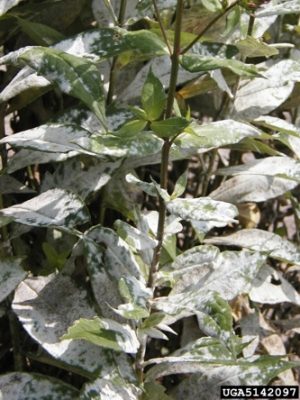Home gardeners may easily recognize powdery mildew by the patches of white fungus growth on the upper leaf surface. Some more commonly infected woody ornamentals include lilac, dogwood, azalea, sycamore and rose. Many perennials may become infected, including garden phlox, bee-balm, aster, yarrow, coreopsis and rudbeckia. In spite of the similar appearance of powdery mildew on these hosts, different species may be responsible for infection. For example, powdery mildew on oak will not infect zinnia.

Powdery mildew thrives in the mid-summer to fall because the warm days followed by cool nights favor disease development. During warm dry days, the powdery mildew spores (reproductive structure of fungi) may be blown to new hosts. The high humidity at night is favorable for spore germination. Unlike most other fungi, powdery mildew spores do not require water on the leaf surface in order to germinate and then infect a leaf.
After spore germination, the powdery mildew fungus grows on the leaf surface and sends sucker-like structures (haustoria) into the plant's epidermal cells (cells in the outer protective layer of plants) in order to obtain nutrients. Powdery mildew fungi need live tissue to grow and reproduce. The powdery mildew fungus may survive the winter as small black pepper-like spores (cleistothecia) that form on the infected leaves in the autumn. In the following year, new infections may begin from the infected leaf litter. Some species of powdery mildew may overwinter in the buds. Removing infected plant material in the autumn will reduce the amount of disease the following year.
Because powdery mildew occurs so late in the season, it may not reduce the long-term health of trees and shrubs. Infections tend to be unsightly and of cosmetic concern.
Prevention
Adequate plant spacing will help to increase the air circulation around plants to discourage disease development. Gardeners should avoid placing plants in a damp, shady corner with poor air circulation that will promote powdery mildew. The cleanup of infected leaves may help to reduce disease inoculums.
Resistant Varieties
Gardeners should first consider the use of species or varieties that are resistant to powdery mildew. The following is a partial list of varieties reported to be resistant. Please see the reference list for additional information.
Monitoring
During conditions favorable for disease development, monitor susceptible plants for the first signs of infection. Initial symptoms may include spotting and curling of the foliage followed by white patches on the leaves. As the disease progresses, foliage and shoots may become distorted, buds may fail to open normally, and foliage may turn chlorotic and yellow. Some leaf drop may occur. As soon as the infection is detected, a preventive fungicide program can begin. Check the label directions for how often the material needs to be applied for specific host plants.
Future Directions
Recently, researchers have investigated the potential use of biorational materials such as potassium bicarbonate, sodium bicarbonate (baking soda), superior horticultural oils and neem oil as possible alternatives to more traditional fungicides. Biorational materials have a relatively short residual on plants and have less of an impact on beneficial organisms than the more traditional pesticides. Additional advantages of these materials include low toxicity to applicators, relative safety to non-target sites and the potential of combined insecticidal and fungicidal activity. Horticultural oil has been reported to control powdery mildew on azalea, bee balm, phlox, crape myrtle, hydrangea, euonymus and rose. Sodium bicarbonate in combination with a 1% horticultural oil spray has been reported to be effective against powdery mildew on roses. However, in a recent study, Maryland researchers reported that the combination of horticultural oil and baking soda was not significantly different from the application of horticultural oil alone in controlling powdery mildew on lilac. The application of sodium bicarbonate without oil failed to control powdery mildew. The researchers felt that perhaps the baking soda without the horticultural oil did not adhere as well to the leaf.
USDA researchers have reported that the oil from the neem seed from the neem tree which is a native of India and Burma controlled powdery mildew on hydrangea, lilac and phlox.
The researchers think that perhaps after a leaf is coated by the neem oil, the powdery mildew spores either fail to germinate or cannot penetrate the leaf. A related product containing the neem seed extract (azadirachtin) is registered as an insecticide (BioNeem).
Biorational materials are not currently registered for use as fungicides for disease control. More testing is needed before the effectiveness of these products is proven. Home remedies have become popular. For example, baking soda mixed with vegetable oils and dishwashing detergent has been used against powdery mildew. There is the potential for phytotoxicity (plant damage) when using either vegetable oils or dishwashing detergent.
Despite good cultural practices, pests and diseases at times may appear. Chemical control should be used only after all other methods have failed.
For pesticide information or other questions please call toll free: 877-486-6271.
References
Auon. 1994. Mildew Resistant Zinnias. Sunset (Central West edition) 192:80 May 1994.
Becker, H. 1994. Neem Oil Locks Out Spores. Agricultural Research, June 1994.
Clement, D.L. S. Gill, and W. Potts. 1994. Alternatives for Powdery Mildew Control on Lilac. Journal of Arboriculture, 20(4) 227-230.
Daughtrey, M.L. and M. Semel. 1987. Herbaceous perennials: Diseases and Insect Pests. Cornell Cooperative Extension Information Bulletin 207
Dutky, E.M. and P. Willow. 1992. Powdery Mildews. Plant Pathology, Mimeo #12. University of MD Cooperative Extension
Horst, R.K. 1990. Westcott's Plant Disease Handbook. 5th edition. NY
Horst, R.K. S.O. Kawanoto, and L.L. Porter. 1992. Effect of bicarbonate and oils on the control of powdery mildew and black sport of roses. Plant Disease, 76:247-251.
Smith-Fiola, D. 1995. Pest Resistant Ornamental Plants. Ornamental landscape plant cultivars and varieties documented to be resistant to specific insects and diseases. Available from Rutgers Cooperative Extension, 1623 Whitesville Road, Toms Rivers, NJ.
Revised by the UConn Home & Garden Education Center, 2016.